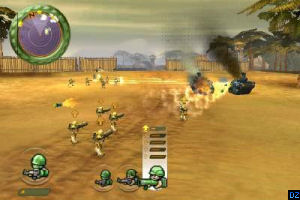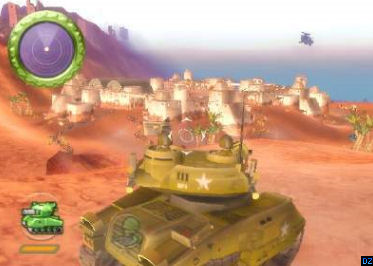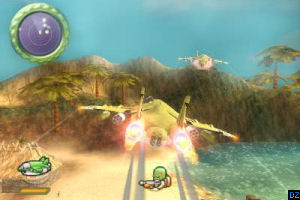Battalion Wars GameCube Review
When an RTS game is played, it is normally a composition of clicking a mouse and preset hotkey pushing. Kuju Entertainment says “No more!” Kuju Entertainment has managed to create something incredibly innovative with the RTS series on a console. What was initially a game people had looked at, shrugged, and then went off to hype the Zelda machine is now a fully loaded gun ready to take the world by storm. Battalion Wars has managed to construct and cross the bridge between the third-person shooter and RTS genres into something totally new and exciting for GameCube owners everywhere.
Gameplay
An armed truce is at hand and the Tundran forces are breaching the no-arms agreement. When the game begins, you’re in a training camp because while your nation (the Western Frontier) is at war with the enemy (Tundra), there is a truce and the general wants his men prepared in case of an attack. However, the Tundrans – more specifically Tzar Gorgi – feel that they are the superior nation and that the Western Frontier shall not be let off easy with a simple no-arms agreement. The Western Frontier responds with a force of their own led by the commander (you). Eventually as a couple of levels are completed, the Tzar loses his confidence in the tundran forces and asks help of another nation – Xylvania. In turn, Xylvania backstabs Tzar Gorgi and attacks both the Western Frontier and Tundra. It’s now up to you to stop the evil Xylvanians and their leader Kaiser Vlad from wiping out the now allied nations.
The game actually plays surprisingly well for an RTS on a console. Players select separate units and groups of units with the c-stick – although the units are in predefined groups which can be restricting. What I find to be somewhat annoying is that the menu you choose your units and groups from will hide itself after not being accessed for a few seconds. It’s quite frustrating because when you want to see what status your units are or how many you have left, you have to take your attention to opening the menu as opposed to continuing to shoot the enemy.
Your role in the game comes in as a single unit – the commander. You’re in charge of all operations your units take on the playing field, and can select any one of them to control in the third person perspective while you send the others out to battle. You can alternate between units by selecting them the same way you normally would or you can locate them on the map and by pressing ‘Z’. Either way will bring you into control of that unit. When commanding the other units, you can set their status so that they will be in a stationary mode or a mode where they will follow you as you travel the map. As for actual control of the unit you chose to control, you can jump, and when locked on to a unit, you can roll to avoid fire from enemy units. When in control of certain units, you can hold down fire and it will charge up your shot which in turn will deal more damage.
Graphics
The best word to describe Battalion Wars‘ graphics is “average”. There is nothing new about the colourful graphics on display here that hasn’t been done before. The game’s art style isn’t generic and the character animation is flawless (and funny) without lag. I found it quite amazing that there is no conflict between the game and frame rate in this title with so much action going on with units and whatnot running, shooting, and jumping every which way. The effects are pretty common; guns will flash orange bullets when shooting and machines will begin to smoke as their hit points and armour are depleted. The one part of the game that seems a bit unusual is that a unit may pause before dying while everything is still shooting it. This is especially noticeable with tanks and recon units.
In terms of the game’s scenery and landscape, again it is nothing new. The land is as flat as ever with very little protruding detail and the actual fill of the land, sky, etc is pretty much normal for a game that doesn’t focus the looks as a major point. While the maps have some areas such as the previously mentioned components that still need some work, the actual design of the layout is quite extraordinary as it restricts the player to a certain course in some places, but is wide enough to allow for the player to explore and carry out a battle strategy.
Perhaps the most stunning part about Battalion Wars is the cut scene between many levels that help progress the story. As farfetched and odd as they may be, the cut scenes are nothing short of highly impressive. The movement is smooth, and the detail is very well done. As simple as the story can be, sometimes you’ll find yourself wanting to complete the level just to see the next cut scene.
Sound
What would a war game be like without the sounds of guns? Press mute and see for yourselves. Boring, no? Battalion Wars like most other games has some sort of tune going on in the background, yet it is very quiet. The game tends to highlight the actual weaponry, explosions, and units as the noise to breach your eardrums before all else does. In a way it is disappointing that it is all you can really hear without an audible tune in the background to help you get more into the feel of the game.
One thing that you will notice if you’re standing still is that the units will make odd little comments such as “Why are we standing around here?” and “I’m cold!” To be concentrating on capturing a victory against your foes and hearing one of these unusual comments can be quite funny at times as it’s a form of comical relief in a time of war. You’ll hear some dialogue within the cut scenes as well which are also considerably funny as the characters displayed have really over exaggerated accents – with the Tundran’s taking the cake with their strong Russian accents.
Lifespan
There isn’t all that much to say about lifespan unless you’re the type that is motivated about a game until you’ve completed every single thing 100%. Otherwise you might get bored really quickly. Battalion Wars allows you to easily keep track of whether or not you’ve completed the 100% mark as it is displayed after you complete a mission and also when on the mission select screen. Obtaining the 100% mark consists of three factors: Speed, Technique, and Power. Speed being how quickly you finish the mission, technique is the way you finish it (you used the appropriate units), and power is how badly you beat your opponent to jelly. Once you’re done playing missions over and over again on the hardest difficulty in one inning, you’ll be dumbfounded with what to do next as there isn’t much else.
What the game’s lifespan truly lacks is a multiplayer to keep people wanting to play the game. Generally people will begin to play multiplayer if they don’t find the story all too invigorating or have completed the story and wish to keep playing. Upon defeat, the game will get old really quickly and will soon be at the bottom of your cube collection. You might want to go back to the game someday when you’ve got nothing new to play, but with a new generation of consoles on the way, it is highly unlikely you’ll be resurrecting this gem for quite a while after you’re bored with it.
Overall
Overall, we’re dealing with a fair piece of software that should be given a try. While the story is pretty straightforward and gameplay is top-notch, the game’s replay value suffers quite heavily from the lack of a multiplayer mode. While I don’t blame Kuju for not including it as the GameCube’s online/LAN service is laughable, I still think that a multiplayer option would have made an outstanding addition to the game and would shift a lot more units past retail cashiers. Although the game is somewhat on the short side with shorter missions; it does pose a challenge if you’re not quick to learn the games dynamics. The deciding factor on whether or not you’ll enjoy this title depends on how motivated you are to complete it. If you’re stuck and don’t want to have to try a mission again to advance, this game isn’t for you.




7.2 out of 10